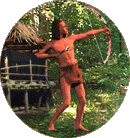The Hopi clans were helped by spirits called Kachinas. They taught the Hopi how to work together, plant crops, irrigate the soil, hunt, gather firewood, keep the village clean, and have the ceremonies. The special ceremonies would keep them in touch with their spirits.
In the thirteenth century the Navajos, the Apaches, and the Utes attacked the Hopis. Hopis mined coal in the seventeenth century to heat their houses and kivas, which are sacred meeting places. When they burned the coal, they used the ashes for their pottery.
In 1540, the Spanish came to the southwest to explore and look for gold. The Hopis were at first scared of the white men. Jesuit missionaries tried to convert the Indians, they made the Hopis the gods of the white men, and they had to work as slaves. Because of that, some of the Hopis got together in the Pueblo in 1680. They killed many white men and forced them to leave. Unfortunately, the Spanish people came back in 1692 and tried to convert the Hopis. The Hopis, to get back at the Spanish, destroyed the churches and forced them to leave. Even though the Hopis were peaceful people the Mexicans, Apaches, and the Navajos stole their crops and ruined their gardens.
The Hopis were very good at farming. There was little rain in the southwest, but the Hopis were very good at farming without water, by using the little water they had. The most important crop that the Hopis had was corn. They grew blue corn, squash, pumpkins, gourds, beans, and cotton.
The men were very good hunters. They got together animals like rabbits, and put them in the middle of the hunters and then they hurt them by throwing sticks at them. Sometimes the men got together and made hunting parties. they traveled in to the Great Plains to hunt for buffalos. When they got them, they drove them into the canyons then they shot them with their bows and arrows. The men and the boys worked in the field. They took away the beans from the pods by hitting them with a stick. The men gathered wood and wove cotton and wool. Animal hides made many things --clothing, moccasins, and drums. Men were the leaders in the secret society. The members met in the clan's kivia. The kivia is an underground room, which was shaped like a rectangle. This was a sacred place.
The Hopis traced their heritage throughout their mother's side. Marriage within the clan was forbidden. The clans were usually named after an animal. The Hopis believed that the name of the animal helps them to be connected with animals' special powers. When a woman was married, the husband and the closest male relatives had to make her wedding, her robes, her belt, and her moccasins. The husband moved into the bride's home. A clan mother had prayer sticks and other sacred items of her clan.
When a baby was born they laid a white corn next to the baby. The corn was supposed to represent mother earth. After twenty days of the birth of the baby, the ear of the corn was rubbed over the baby to bless it in the naming ceremony. This was repeated when the baby took part in a clan, when he or she became an adult. When the baby was sixth months, an older sister watched him or her, when the baby reached four years they were allowed to go anywhere they wanted in the village. Usually, young children had no clothing on, but were then dressed like an adult. The girls went with their mothers to get water and the boys did other things with their fathers. When the boys were six years old, they were able to help their fathers in the field. When a boy was seven he could take part in the ceremonies. Girls could learn about the ceremonies but did not belong to the kiva. When girls were older than six, they had to take care of the youngest or the next to youngest child in their family. The older girls had to help carry water, sweep the floor, take care of the gardens, and cook. When girls were twelve they had to stay at home. The girl could never leave the house without an older woman. When the girl was old enough to marry her hair was made into a "squash blossom." When the girl married her hair was made into two braids. When the boy was twenty-one, he was given a new name that was used for the rest of his life.
The Hopis believed they had to take care of the earth. The rituals the Hopis had represented the way of life from birth until death. The Hopis had a ceremonial year, which was divided into two.
In 1848 Arizona and New Mexico became part of the United States. In 1849,the Indians of the Southwest were given an agent by the US government. In 1851, Fort Defiance was built to control the Navajos. When white explorers and tourists came to visit the fort, they brought small pox with them, and in 1853-54 it killed hundreds of Hopis.
Over many years the lands of the Hopis were surrounded by the Navajo reservation. They lost so much land and were unhappy about it. Today, Hopis work in any fields, not just the things they did before.
